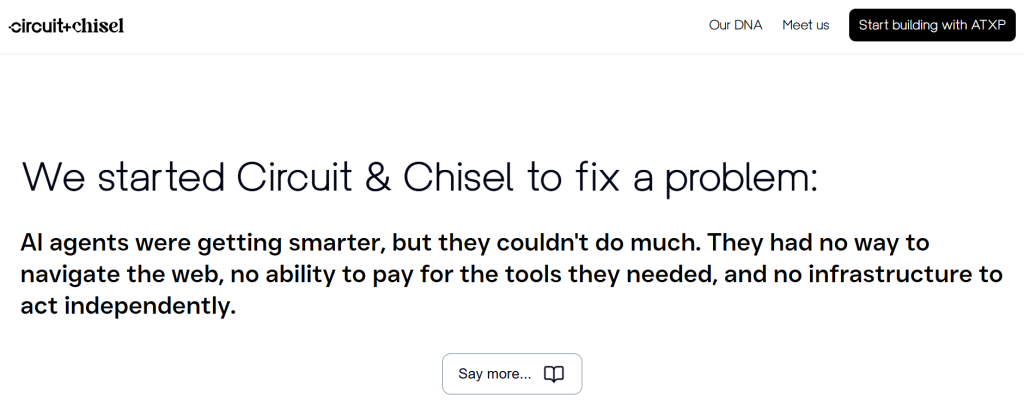Circuit & Chisel Raises $19.2M Seed Round to Build for the Agentic Age
September 23, 2025
byFenoms Start-Ups

Circuit & Chisel, a New York–based startup, announced the close of its $19.2 million Seed round. The company is setting out to shape the emerging “agentic age,” an era defined by intelligent, autonomous AI systems that act as agents capable of driving business outcomes, not just processing tasks.
The round attracted an impressive lineup of investors, including Primary Venture Partners, ParaFi Capital, Stripe, and Polygon Labs. For a Seed round, this investor mix signals high conviction and underscores just how critical the agentic paradigm is becoming in the technology landscape.
Founded by Louis Amira, Circuit & Chisel is designed to push the boundaries of how AI interacts with humans and businesses - shifting away from static prompts and into dynamic systems that can execute, adapt, and build.
Why “Agentic Age” Matters
The phrase “agentic age” is gaining traction in Silicon Valley, and it’s more than just hype. Instead of AI being a passive tool, we’re seeing the birth of autonomous AI agents that can:
- Manage end-to-end workflows with minimal human input
- Interact across platforms and systems in real time
- Adapt to context, goals, and constraints like a digital teammate
For startups and enterprises alike, this shift could dramatically lower operational friction, reduce human error, and expand productivity in ways current SaaS tools can’t match.
The $19.2M Backing and Investor Signal
The investors in this round tell a story about where AI is heading:
- Primary Venture Partners (NY-based Investment Management) brings early-stage expertise in scaling tech startups.
- ParaFi Capital (Greenwich, CT), best known for its Web3 and fintech investments, adds credibility to Circuit & Chisel’s exploration of decentralized and AI-driven future markets.
- Stripe, one of the most significant players in fintech and developer ecosystems, is not just a capital partner but a signal that agentic AI may soon integrate with financial infrastructure.
- Polygon Labs, a leader in Web3 scalability, hints that agentic systems may connect deeply with blockchain and decentralized computing.
Seed rounds are rarely stacked with names like Stripe or Polygon - this backing is as much a strategic bet as it is financial support.
An Insight Founders Need to Hear
Here’s the tricky reality about this shift: startups entering the agentic age must design for orchestration, not just intelligence. Too many AI-first companies focus entirely on model performance - accuracy, reasoning, speed - without building the connective tissue that allows these agents to actually move across real-world systems.
What differentiates agentic winners won’t just be “smarter” models. It will be seamless orchestration across APIs, legacy systems, and human workflows. Think of it like the early days of the internet - everyone was obsessed with browsers, but the massive value was unlocked by protocols and connectivity.
If you’re building in this space, consider designing your product with orchestration layers baked in from the start. It’s not the model itself that builds durable moats - it’s the way your system coordinates and integrates across the enterprise stack. That’s the competitive edge in the agentic age.
The Founder’s Lens
Louis Amira, co-founder of Circuit & Chisel, is known for tackling exponential change with a focus on practical adoption. His philosophy revolves around taking “exponential curves” that often feel abstract and grounding them in business applications people can use today.
That pragmatic lens may explain why this round resonated with Stripe and Polygon. While the market is flush with noise around autonomous AI, Circuit & Chisel is focused on building a platform that enterprises can actually trust, implement, and scale.
Industry Outlook: AI Agents and Market Growth
The global AI software market is expected to surpass $1 trillion by 2030, according to PwC, with autonomous agents projected to be one of the fastest-growing segments. Gartner predicts that by 2027, over 40% of enterprise workloads will be managed by AI agents - a radical shift from today’s less than 5%.
In the venture landscape, 2025 is already showing momentum:
- Over $22 billion has been invested globally in generative and agentic AI startups in the first half of the year alone.
- Early adopter industries include financial services, healthcare, and supply chain management, where AI agents are already proving to reduce compliance costs and accelerate decision-making.
What’s clear is that the agentic age isn’t a futuristic concept anymore - it’s unfolding in real time. Circuit & Chisel’s $19.2M raise positions it as one of the early companies set to shape how enterprises adopt and scale autonomous AI systems.
Final Word
Circuit & Chisel’s raise marks more than just another AI funding headline. It reflects the rapid acceleration toward the agentic age - a world where companies don’t just “use” AI, but partner with it as an autonomous actor. With backing from high-profile investors like Stripe and Polygon Labs, and the sharp leadership of Louis Amira, this is a startup worth watching as the lines between automation and true autonomy blur.









